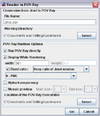Difference between revisions of "File formats/Images"
AngelHerraez (talk | contribs) (→Saving images from Jmol application) |
AngelHerraez (talk | contribs) (→Saving images from Jmol application) |
||
| Line 6: | Line 6: | ||
<code>File > Export > Export Image</code>. A dialog will open to allow choosing the location and filename, as well as the format in the <code>Image Type</code> drop-down list; choose among <code>JPEG</code>, <code>PNG</code>, <code>PPM</code> or <code>GIF</code> formats. | <code>File > Export > Export Image</code>. A dialog will open to allow choosing the location and filename, as well as the format in the <code>Image Type</code> drop-down list; choose among <code>JPEG</code>, <code>PNG</code>, <code>PPM</code> or <code>GIF</code> formats. | ||
| − | [[Image:POV-RayExportDialog.png | + | [[Image:POV-RayExportDialog.png|100px|right|POV-Ray export dialog]] |
The menu also has <code>File > Export > Render in POV-Ray</code>, which produces images that can be displayed and edited in this raytracing program (using a dialog with options). | The menu also has <code>File > Export > Render in POV-Ray</code>, which produces images that can be displayed and edited in this raytracing program (using a dialog with options). | ||
:''Note: GIF format is only available in recent versions of Jmol.'' | :''Note: GIF format is only available in recent versions of Jmol.'' | ||
Revision as of 12:24, 25 April 2009
File Formats for Images Exported from Jmol
Saving images from Jmol application
Images (snapshots) of Jmol's viewport, including the model in the current rendering, can be saved by using the application's top menu bar:
File > Export > Export Image. A dialog will open to allow choosing the location and filename, as well as the format in the Image Type drop-down list; choose among JPEG, PNG, PPM or GIF formats.
The menu also has File > Export > Render in POV-Ray, which produces images that can be displayed and edited in this raytracing program (using a dialog with options).
- Note: GIF format is only available in recent versions of Jmol.
Information on these image formats and POV-Ray on Wikipedia.
Saving images from Jmol application and signed applet
The pop-up menu also allows in these cases (not in the normal, unsigned applet) to save a snapshot of the model, in JPEG, PNG or POV-Ray (raytracing) formats. Open the pop-up menu (right-click, or Ctrl+click, or click on Jmol frank) and choose Save. A dialog will open to choose the location and filename.
Saving images from Jmol applet
These methods work for both signed and unsigned applet, but for the first the method above is more convenient.
Basic method
Note: This only works for certain browsers, so it is not a general solution for the general user. In particular, it does not work in MSIE. In Firefox, it may fail for large applet sizes.
The command from the console or via JavaScript is
getProperty image.
The result is a base-64 encoded JPEG image that looks like this:
/9j/4AAQSkZJRgABAAAAAQABAAD//gBBSl...
Pop that into an <img> tag using Firefox or Opera (not MSIE), and you have
an image that you can copy into your clipboard and do anything you would
do with a JPG. The JavaScript required to create the tag looks like this:
var myImage = jmolGetPropertyAsString("image")
document.getElementById("someDiv").innerHTML =
'<img src="data:image/jpeg;base64,' + myImage + '">'
Example: Bob Hanson's examples page (Just under the applet, click on the word "image".)
General method, using Perl
This works in any browser. The author must have access to the web server and be able to use a Perl script there.
It sends the "base64" encoded image (described above) to a perl
script on the server. This script uses the MIME::Base64 package to decode the image (MIME::Base64::decode($data)) and sends it back to the browser, embedded in an HTML page.
Example code:
HTML file and Javascript (client side):
<html>
<head>
<script type="text/javascript">
function get_snapshot()
{
var BI = document.getElementById("bounce_image");
var BI_D = document.getElementById("IMAGE_DATA");
var BASE64 = jmolGetPropertyAsString("image");
BI_D.value = BASE64;
BI.submit();
}
</script>
</head>
<body>
<script type="text/javascript">
jmolInitialize("jmol/");
jmolApplet(350,"load something.pdb");
</script>
<input type="button" id="snapshot" value="snapshot"
onclick='get_snapshot()'>
<form id="bounce_image"
action="http://MY.SERVER.COM/cgi-bin/decode_snapshot.pl"
method="post" target="_blank">
<input type="hidden" id="IMAGE_DATA" name="IMAGE_DATA"
value="empty">
</form>
</body>
</html>
PERL script (server side) file 'decode_snapshot.pl':
#!/usr/bin/perl
use MIME::Base64;
print "Content-type: image/jpeg\n\n";
%postFields = ();
read( STDIN, $tmpStr, $ENV{ "CONTENT_LENGTH" } );
@parts = split( /\&/, $tmpStr );
foreach (@parts) {
s/%([0-9A-F][0-9A-F])/pack("c",hex($1))/ge;
( $name, $value ) = split(/\=/);
$postFields{ "$name" } = $value;
}
$decoded = decode_base64($postFields{"IMAGE_DATA"});
open (MYFILE, '>path_to_file/jmol_snapshot.jpg');
print MYFILE $decoded;
close (MYFILE);
print $decoded;
exit;
It is also possible to add additional information to the page containing the generated image (like in the example below).
Example: http://www.fli-leibniz.de/cgi-bin/3d_mapping.pl?CODE=1deh (click on the "snapshot" button in the "Graphics Window" section).
General method, using just HTML, and PHP if necessary
This works in any browser. The server must support PHP, but no configuration is needed.
- No access to server configuration is needed (i.e., no need to install server-side scripts).
- If the browser is MS Internet Explorer, it needs online access to a PHP-enabled server that will return the image using a php page which is part of this package.
- If the browser is another, inline base64-encoded images will be used first (understood by Firefox and Opera, at least). This method works both online and off-line (e.g., from hard disk, USB disk or CDROM).
The image is opened in a new window, that fits the image size. It can then be copied to clipboard using the browser's pop-up menu on it. Some browsers also allow to save the image to disk, from the same pop-up menu.
Example and downloadable kit: http://biomodel.uah.es/Jmol/export-image/
See also
File_formats/3D_Objects to export to POV-Ray, VRML, Maya, or OBJ.
